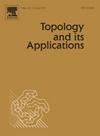低属面最小分离集的分类
IF 0.5
4区 数学
Q3 MATHEMATICS
引用次数: 0
摘要
连通拓扑空间X中的最小分离集是一个子集L∧X,其性质是X∈L是不连通的,但如果L ‘是L的固有子集,则X∈L ’是连通的。这样的集合出现在各种上下文中。例如,在广泛的度量空间中,如果我们选择不同的点p和q,那么点x满足d(x,p)=d(x,q)的集合是最小分离的。在这里,我们分类哪些拓扑图可以被实现为低格曲面上的最小分离集。一般来说,图能否嵌入曲面是一个难题,所以我们的工作部分是计算性的。我们对给定属中最小分离的图嵌入进行了分类,并编写了一个计算机程序来查找所有这样的嵌入和底层图。本文章由计算机程序翻译,如有差异,请以英文原文为准。
Classification of minimal separating sets of low genus surfaces
A minimal separating set in a connected topological space X is a subset with the property that is disconnected, but if is a proper subset of L, then is connected. Such sets appear in a variety of contexts. For example, in a wide class of metric spaces, if we choose distinct points p and q, then the set of points x satisfying are minimal separating. Here we classify which topological graphs can be realized as minimal separating sets in surfaces of low genus. In general the question of whether a graph can be embedded at all in a surface is a difficult one, so our work is partly computational. We classify graph embeddings which are minimal separating in a given genus and write a computer program to find all such embeddings and underlying graphs.
求助全文
通过发布文献求助,成功后即可免费获取论文全文。
去求助
来源期刊
CiteScore
1.20
自引率
33.30%
发文量
251
审稿时长
6 months
期刊介绍:
Topology and its Applications is primarily concerned with publishing original research papers of moderate length. However, a limited number of carefully selected survey or expository papers are also included. The mathematical focus of the journal is that suggested by the title: Research in Topology. It is felt that it is inadvisable to attempt a definitive description of topology as understood for this journal. Certainly the subject includes the algebraic, general, geometric, and set-theoretic facets of topology as well as areas of interactions between topology and other mathematical disciplines, e.g. topological algebra, topological dynamics, functional analysis, category theory. Since the roles of various aspects of topology continue to change, the non-specific delineation of topics serves to reflect the current state of research in topology.
At regular intervals, the journal publishes a section entitled Open Problems in Topology, edited by J. van Mill and G.M. Reed. This is a status report on the 1100 problems listed in the book of the same name published by North-Holland in 1990, edited by van Mill and Reed.

 求助内容:
求助内容: 应助结果提醒方式:
应助结果提醒方式:


